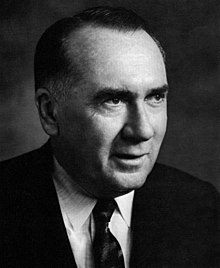| This article includes a list of general references, but it lacks sufficient corresponding inline citations. Please help to improve this article by introducing more precise citations. (February 2020) (Learn how and when to remove this message) |
| Cal Rampton | |
|---|---|
 | |
| 11th Governor of Utah | |
| In office January 4, 1965 – January 3, 1977 | |
| Lieutenant | Clyde L. Miller |
| Preceded by | George Clyde |
| Succeeded by | Scott Matheson |
| Chair of the National Governors Association | |
| In office June 2, 1974 – June 8, 1975 | |
| Preceded by | Daniel J. Evans |
| Succeeded by | Robert D. Ray |
| Personal details | |
| Born | Calvin Lewellyn Rampton (1913-11-06)November 6, 1913 Bountiful, Utah, U.S. |
| Died | September 16, 2007(2007-09-16) (aged 93) Holladay, Utah, U.S. |
| Resting place | Salt Lake City Cemetery |
| Political party | Democratic |
| Spouse | Lucybeth Cardon |
| Children | 4 |
| Education | University of Utah (BA) George Washington University (LLB) |
| Military service | |
| Allegiance | |
| Branch/service | |
| Battles/wars | World War II |
Calvin Lewellyn "Cal" Rampton (November 6, 1913 – September 16, 2007) was an American attorney and politician who served as the 11th governor of Utah from 1965 to 1977.
With a tenure spanning for 12 years, he is both the longest serving Governor governor of Utah, and the only Democrat to have served more than two terms.
Early life and education
He was born to Llewellyn Smith Rampton and Janet Campbell in Bountiful, Utah. Following his graduation from Davis High School in 1931, Rampton took over his family's automobile business, due to his father's death that same year. He sold the business in 1933 and entered the University of Utah, graduating in 1936. He also studied at the George Washington University Law School while working as administrative assistant to Congressman J. W. Robinson.
Career
Rampton served as Davis County Attorney from 1938 to 1940, the only other public office he would be elected to until becoming governor in 1965.
Rampton served in Europe during World War II as Chief of the Army Claims Commission in Paris; he attained the rank of major and received the Bronze Star Medal. Rampton continued to serve in the Army Reserve and attained the rank of colonel before retiring. After the war he pursued a career as an attorney and his success in civil trial practice earned him a fellowship with the International Academy of Trial Lawyers. He was a Democratic candidate for the Utah State Senate in 1954 and United States Senate in 1962.
He was elected Governor of Utah in 1964, winning just under 57% of the vote over Republican Mitchell Melich. He would be re-elected in 1968 with over 68% of the vote and re-elected to a third term in 1972 with over 69% of the vote. In 1968, he would win every county in the state except for Kane, which would go for his Republican opponent Carl W. Buehner. In 1972, Rampton would flip Kane, but lose Uintah County to his Republican opponent Nicholas L. Strike, meaning that twice he won every county in the state except for one. He is the only governor of Utah to serve three full consecutive terms, and was one of the most popular governors in the country.
During his governorship, he successfully advocated for increased education spending, civil rights legislation, and allocating federal funds for urban renewal. He was a supporter of the Equal Rights Amendment to the U.S. Constitution, and advocated successfully for state construction projects, including Salt Lake City’s Symphony Hall (now Abravanel Hall) and the Salt Lake Arts Center (now Utah Museum of Contemporary Art).
After leaving office, Rampton practiced law until he retired at the age of 75.
Personal life
Rampton married Lucybeth Cardon (1914–2004) on March 10, 1940; they had four children.
In 2007, Rampton died of cancer in Holladay, Utah. Shortly after his death, the Salt Palace Convention Center in Salt Lake City was also named in his honor. The Calvin L. Rampton Complex in Taylorsville, which houses the Utah Department of Transportation and the Utah Department of Public Safety, is also named in his honor.
In popular culture
In the made-for-television movie The Executioner's Song, Rampton is referenced in a recreated radio news clip as having requested the Utah Board of Pardons to review convicted murderer Gary Gilmore's execution just before the end of his final term. Rampton's successor Scott M. Matheson declined to get involved in the matter, and the execution was soon carried out.
Sources
- Cal Rampton: Former three-term governor dies at 93
- Utah History Research Center
- An Interview with Former Gov. Rampton
References
| Party political offices | ||
|---|---|---|
| Preceded byWilliam Barlocker | Democratic nominee for Governor of Utah 1964, 1968, 1972 |
Succeeded byScott Matheson |
| Political offices | ||
| Preceded byGeorge Clyde | Governor of Utah 1965–1977 |
Succeeded byScott Matheson |
| Preceded byDaniel J. Evans | Chair of the National Governors Association 1974–1975 |
Succeeded byRobert D. Ray |
| Governors of Utah | ||
|---|---|---|
| Territorial (1850–1896) |  | |
| State (since 1896) | ||
- 1913 births
- 2007 deaths
- 20th-century Utah politicians
- American businesspeople in retailing
- American people of English descent
- American people of Manx descent
- American people of Scottish descent
- Burials at Salt Lake City Cemetery
- Deaths from cancer in Utah
- Democratic Party governors of Utah
- George Washington University Law School alumni
- Latter Day Saints from Utah
- People from Bountiful, Utah
- United States congressional aides
- University of Utah alumni